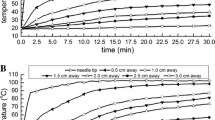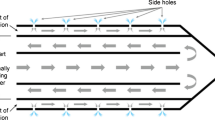Abstract
Purpose
To evaluate the coagulative performance of a 21-gauge (G) internally cooled radiofrequency (RF) electrode using ex vivo and in vivo rat liver.
Materials and Methods
We developed a prototype of 21-G internally cooled monopolar RF electrode with 5.0 mm active tip length. The ablative zone size created by this electrode was evaluated in ex vivo and in vivo rat liver. Five RF powers (3 W, 5 W, 7 W, 9 W, and 11 W) were applied with and without circulation of chilled water within the electrode. The ablation zone sizes were compared. Histopathological evaluation of the ablation zone was also performed at 24 h and at 7 days after RF ablation.
Results
From ex vivo experiments, the ablation volume was found to increase significantly when RF energy was applied with the chilled water circulation. Results of in vivo experiments demonstrate that the ablation volume reached its maximum value when RF power of 7 W was applied (532.3 ± 110.3 mm3). Histopathological examination showed delineated coagulation necrosis at 24 h after RF ablation, which clarified the ablation zone border. Fibrotic change was also observed at 7 days after RF ablation.
Conclusion
RF ablation using a 21-gauge electrode produced coagulation necrosis in the rat liver. The ablation volume became maximum when RF power of 7 W was applied with chilled water circulation.





Similar content being viewed by others
References
Liapi E, Geschwind JF. Transcatheter and ablative therapeutic approaches for solid malignancies. J Clin Oncol. 2007;25:978–86.
Patel V, Ritchie CA, Padula C, McKinney JM. Radiofrequency ablation, where it stands in interventional radiology today. Semin Interv Radiol. 2019;36:398–404.
Cui S, Heller HT, Waikar SS, McMahon GM. Needle size and the risk of kidney biopsy bleeding complications. Kidney Int Rep. 2016;1(4):324–6.
Kuban JD, Tam AL, Huang SY, Ensor JE, Philip AS, Chen GJ, Ahrar J, Murthy R, Avritscher R, Madoff DC, Mahvash A, Ahrar K, Wallace MJ, Nachiappan AC, Gupta S. The effect of needle gauge on the risk of pneumothorax and chest tube placement after percutaneous computed tomographic (CT)-guided lung biopsy. Cardiovasc Interv Radiol. 2015;38(6):1595–602.
Mulier S, Ni Y, Frich L, Burdio F, Denys AL, De Wispelaere JF, Dupas B, Habib N, Hoey M, Jansen MC, Lacrosse M, Leveillee R, Miao Y, Mulier P, Mutter D, Ng KK, Santambrogio R, Stippel D, Tamaki K, van Gulik TM, Marchal G, Michel L. Experimental and clinical radiofrequency ablation: proposal for standardized description of coagulation size and geometry. Ann Surg Oncol. 2007;14(4):1381–96.
Song KD, Lee MW, Park HJ, Cha DI, Kang TW, Lee J, Moon JY, Rhim H. Hepatic radiofrequency ablation: in vivo and ex vivo comparisons of 15-gauge (G) and 17-G internally cooled electrodes. Br J Radiol. 2015;88(1050):20140497.
Lee JD, Lee JM, Kim SW, Kim CS, Mun WS. MR imaging-histopathologic correlation of radiofrequency thermal ablation lesion in a rabbit liver model: observation during acute and chronic stages. Korean J Radiol. 2001;2(3):151–8.
Goldberg SN, Gazelle GS, Solbiati L, Rittman WJ, Mueller PR. Radiofrequency tissue ablation: increased lesion diameter with a perfusion electrode. Acad Radiol. 1996;3(8):636–44.
Lorentzen T. A cooled needle electrode for radiofrequency tissue ablation: thermodynamic aspects of improved performance compared with conventional needle design. Acad Radiol. 1996;3(7):556–63.
Heerink WJ, Solouki AM, Vliegenthart R, Ruiter SJS, Sieders E, Oudkerk M, de Jong KP. The relationship between applied energy and ablation zone volume in patients with hepatocellular carcinoma and colorectal liver metastasis. Eur Radiol. 2018;28(8):3228–366.
Funding
This research was funded by a research grant from the Children’s Cancer Association of Japan and JSPS KAKENHI Grant Number JP 19K08108.
Author information
Authors and Affiliations
Corresponding author
Ethics declarations
Conflict of interest
The authors declare that they have no conflict of interest.
Ethical Approval
All animal procedures were performed in compliance with the study protocol approved by the animal care and use committee at our institution. All applicable international, national, and/or institutional guidelines for the care and use of animals were followed. All procedures performed in studies involving animals were in accordance with the ethical standards of the institution or practice at which the studies were conducted. This article does not contain any studies with human participants performed by any of the authors.
Consent for Publication
For this type of study consent for publication is not required.
Informed Consent
For this type of study informed consent is not required.
Additional information
Publisher's Note
Springer Nature remains neutral with regard to jurisdictional claims in published maps and institutional affiliations.
Rights and permissions
About this article
Cite this article
Takaki, H., Kodama, Y., Miyamoto, H. et al. Radiofrequency Ablation by a 21-Gauge Internally Cooled Electrode: Ex Vivo and In Vivo Evaluation by Rat Liver. Cardiovasc Intervent Radiol 44, 150–155 (2021). https://doi.org/10.1007/s00270-020-02660-w
Received:
Accepted:
Published:
Issue Date:
DOI: https://doi.org/10.1007/s00270-020-02660-w




